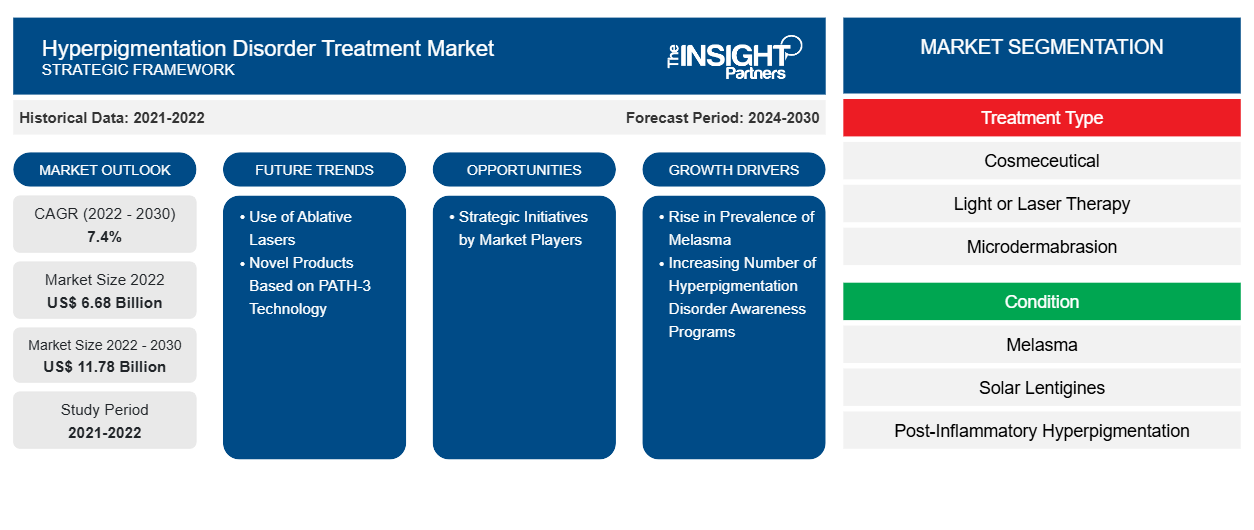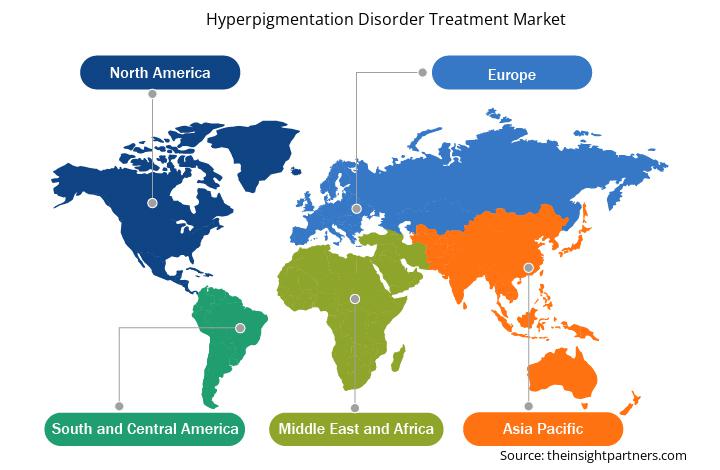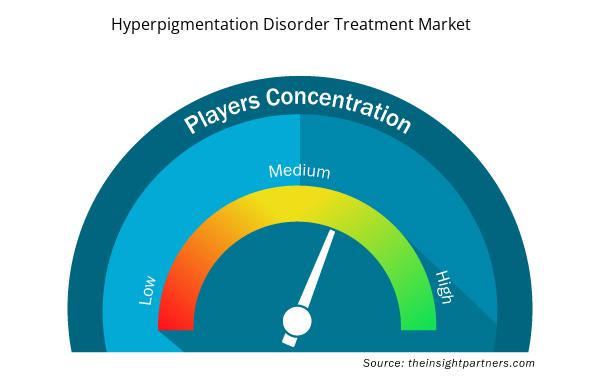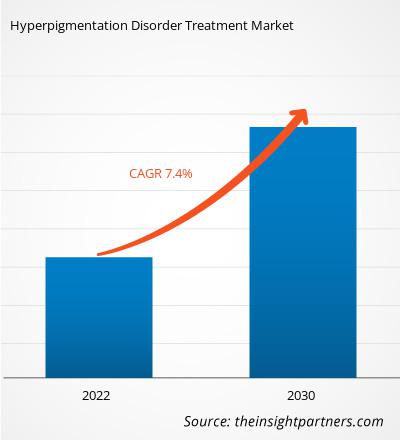色素沉着症治疗市场预测可以帮助该市场的利益相关者制定增长战略。预计该市场将从 2022 年的 66.8 亿美元增长到 2030 年的 117.8 亿美元;预计 2022-2030 年的复合年增长率为 7.4%。
简化和微创手术、广泛的应用范围以及技术进步带来的舒适度、效率和效果的改善等因素推动了 色素沉着症治疗市场的发展。然而,潜在的副作用和监管挑战阻碍了市场的增长。基于 path-3 技术的新产品的日益普及预计将在未来几年为色素沉着症治疗市场带来新趋势。
增长动力:
越来越多的色素沉着障碍宣传计划推动市场增长
开展活动以提高人们对紫外线引起的皮肤色素沉着的认识对于教育普通民众预防、筛查、诊断和治疗这些疾病至关重要;他们还讨论了使用优质防晒产品控制这些疾病的重要性。
- 2022 年 5 月 25 日,贝拉·奥罗拉 (Bella Aurora) 庆祝国际皮肤色素沉着日。凭借 130 多年的皮肤色素沉着研究经验,贝拉·奥罗拉在美国、西班牙、意大利和墨西哥的知名皮肤科医生、药剂师和关键意见领袖的支持下发起了一项国际宣传活动来庆祝这一天。
- 2021 年 6 月,Dermalogica Clear 发起了一项活动,旨在鼓励人们接受皮肤,并教育受众了解炎症后色素沉着、痤疮、痘痘等。
- 印度 Zydus Healthcare 于 2023 年 4 月 1 日至 5 月 31 日开展了全国性黄褐斑宣传运动,也称为“面向世界”活动,以提高人们对黄褐斑的认识。2023 年 8 月,Zydus Healthcare 创下了参与该活动的最大医疗保健专业人员 (HCP) 记录,共有 18,737 名 HCP 参与了该活动,他们为让大量患者了解黄褐斑做出了贡献。
人们对黄褐斑和其他色素沉着症的认识不断提高,导致对创新有效的治疗产品和程序的需求激增。此外,它还为社会理解和管理色素沉着带来了重大而积极的变化。因此,越来越多的宣传计划促进了色素沉着症治疗市场的增长。
定制此报告以满足您的需求
您可以免费定制任何报告,包括本报告的部分内容、国家级分析、Excel 数据包,以及为初创企业和大学提供优惠和折扣
色素沉着症治疗市场:

- 获取此报告的关键市场趋势。这个免费样品将包括数据分析,从市场趋势到估计和预测。
限制:
治疗费用高昂
成本是选择性手术或治疗的一个重要因素。药妆、化学换肤、冷冻疗法、光疗或激光疗法、微晶磨皮和其他色素沉着治疗的成本取决于所采用的技术类型、过程或疗法所需的时间和精力、设施的地理位置以及执行治疗的外科医生的专业知识。此外,健康保险不涵盖色素沉着治疗。色素沉着治疗成本非常高。例如,评级最高的活性成分水杨酸每盎司售价近 15.00 美元。此外,曲酸是所有活性成分中成本最高的,即每盎司 24.89 美元,远高于防晒产品的成本(每盎司中位数 3.32 美元)。使用防晒霜是推荐的一线色素沉着治疗方法。
根据美国整形外科医师协会提供的定价详情,几种流行的色素沉着治疗的平均费用如下:
- 微晶磨皮:2,000 美元
- 皮肤重塑手术:1,489 美元
- 微针疗法:300-1,200 美元
- 磨皮/换肤:1,250-4,500 美元(视地点而定)
- 去皮:125-350 美元
- 激光治疗:250 美元或以上
- 化学换肤疗程:519 美元
上述费用不包括手术室费用或麻醉费用。此外,保险很少涵盖皮肤剥脱、皮肤重修和激光治疗等美容手术。因此,色素沉着治疗的高成本限制了色素沉着症治疗市场的增长。
趋势:
烧蚀激光的使用
用于治疗色素沉着的激光设备已经取得了许多进展。烧蚀激光器,例如铒:YAG (Er:YAG) 和二氧化碳 (CO2) 已用于治疗痤疮疤痕。然而,副作用导致这种技术的普及度下降。随后,非烧蚀激光器,例如 NdYAG 激光器和铒玻璃,在色素沉着治疗中获得了关注。虽然这种技术风险较小,但由于效果不佳,因此并不可靠。随着分数技术的进步,使用 CO2 和铒 YAG 等烧蚀激光器治疗色素沉着已重新流行起来。因此,预计在预测期内,使用 CO2 和 Er:YAG 等烧蚀激光器将带来新的色素沉着障碍治疗市场趋势。
报告细分和范围:
色素沉着症治疗市场分析是通过考虑以下几个部分进行的:治疗类型、病情和最终用户。
根据治疗类型,市场细分为药妆、光疗或激光疗法、微晶换肤、化学换肤、冷冻疗法等。2022 年,药妆领域占据了色素沉着障碍治疗市场的最大份额。药妆兼具美容和药用功能,在护肤领域获得了极大的关注,尤其是在解决色素沉着等问题方面。强效活性药物成分与化妆品配方相结合,可有效针对特定的皮肤问题。对于色素沉着的治疗,药妆的效果超越了传统的护肤产品,可以淡化黑斑、均匀肤色和增强皮肤光泽。维生素 C、烟酰胺、曲酸和 α 羟基酸等成分通常存在于专为色素沉着而设计的药妆配方中,具有提亮和调节色素的特性。将先进的药物成分与药妆配方相结合,可提供有针对性的治疗方法,帮助解决与黑色素生成、皮肤变色和色素沉着不均匀相关的问题,从而促进肤色更加均衡和有光泽。此外,微晶磨皮细分市场预计将在预测期内实现最高的复合年增长率。
根据病症,市场分为黄褐斑、日光性雀斑、炎症后色素沉着和其他。黄褐斑领域在 2022 年占据了色素沉着障碍治疗市场的最大份额。预计在预测期内,该领域将录得最高的复合年增长率。
根据最终用户,市场分为医院、皮肤病中心和其他。医院部分在 2022 年占据了最大的市场份额。此外,预计皮肤病中心部分在预测期内的复合年增长率最高。
区域分析:
从地域上看,色素沉着症治疗市场报告的范围包括北美、欧洲、亚太地区、南美和中美以及中东和非洲。2022 年,北美占据了最大的市场份额。提供色素沉着症治疗服务的诊所和医院数量不断增加,产品获批和上市数量不断增加,推动了加拿大色素沉着症治疗市场的增长。例如,2023 年 3 月,加拿大医疗器械公司 Candela 的皮秒激光系统获得了加拿大卫生部的批准,该系统此前已获准用于良性色素病变治疗、纹身去除、痤疮疤痕治疗和皱纹减少手术等。这些因素共同促进了北美色素沉着症治疗市场规模的扩大。
色素沉着症治疗市场区域洞察
Insight Partners 的分析师已详尽解释了预测期内影响色素沉着症治疗市场的区域趋势和因素。本节还讨论了北美、欧洲、亚太地区、中东和非洲以及南美和中美洲的色素沉着症治疗市场细分和地理分布。

- 获取色素沉着过度治疗市场的区域特定数据
色素沉着症治疗市场报告范围
| 报告属性 | 细节 |
|---|---|
| 2022 年市场规模 | 66.8亿美元 |
| 2030 年的市场规模 | 117.8亿美元 |
| 全球复合年增长率(2022 - 2030 年) | 7.4% |
| 史料 | 2021-2022 |
| 预测期 | 2024-2030 |
| 涵盖的领域 | 按治疗类型
|
| 覆盖地区和国家 | 北美
|
| 市场领导者和主要公司简介 |
|
色素沉着过度症治疗市场参与者密度:了解其对业务动态的影响
色素沉着过度症治疗市场正在快速增长,这得益于终端用户需求的不断增长,这些需求源于消费者偏好的不断变化、技术进步以及对产品优势的认识不断提高等因素。随着需求的增加,企业正在扩大其产品范围,进行创新以满足消费者的需求,并利用新兴趋势,从而进一步推动市场增长。
市场参与者密度是指在特定市场或行业内运营的企业或公司的分布情况。它表明在给定市场空间中,相对于其规模或总市场价值,有多少竞争对手(市场参与者)存在。
在色素沉着过度治疗市场运营的主要公司有:
- 艾伯维公司(AbbVie Inc.)
- 拜耳公司,
- Epipharm AG,
- 高德美实验室,
- Obagi 药妆品有限公司,
- 陆创尼公司
免责声明:上面列出的公司没有按照任何特定顺序排列。

- 了解色素沉着症治疗市场顶级关键参与者概况
行业发展和未来机遇:
根据公司新闻稿,色素沉着症治疗市场主要参与者的一些战略发展如下:
- 2024 年 2 月,巴黎欧莱雅推出了乙醇酸亮白黑眼圈眼部精华液,这是一款突破性的眼部色素沉着和浮肿解决方案。该精华液由 3% 乙醇酸、维生素 CG 和烟酰胺混合而成,承诺在短短 2 周内减少 49% 的黑眼圈。该精华液经过眼科测试,适合所有皮肤类型,并经临床证明可治疗明显的黑眼圈。
- 2023 年 10 月,Galderma 在加拿大和英国两个重要市场拓展了其护肤品牌 Alastin。Galderma 宣布计划在加拿大直接分销 Alastin,并在英国推出该品牌。Galderma 在这两个市场的美学业务扩张将提高 Alastin 的知名度,并有助于推动医疗保健专业人士和消费者采用该品牌。
- 2023 年 1 月,AbbVie 公司的子公司 Allergan Aesthetics 推出了 SkinMedica Even & Correct Collection。该产品系列由三款产品组成:高级亮白护理霜、暗斑霜和亮白护理垫,旨在提供有针对性的效果,并协同作用均匀肤色,减少面部色素沉着和暗斑的出现。
竞争格局和重点公司:
AbbVie Inc、Bayer AG、Epipharm AG、Galderma Laboratories、Obagi Cosmeceuticals LLC、Lutronic Corporation、La Pristine、L'oreal SA、Pierre Fabre Group 和 Vivier Pharma USA 是色素沉着症治疗市场报告中介绍的知名公司。这些公司专注于开发新技术、升级现有产品并扩大其地理覆盖范围,以满足全球日益增长的消费者需求。
- 历史分析(2 年)、基准年、预测(7 年)及复合年增长率
- PEST 和 SWOT 分析
- 市场规模价值/数量 - 全球、区域、国家
- 行业和竞争格局
- Excel 数据集


- Small Internal Combustion Engine Market
- Dry Eye Products Market
- Redistribution Layer Material Market
- Virtual Pipeline Systems Market
- Sterilization Services Market
- Surgical Gowns Market
- Non-Emergency Medical Transportation Market
- Investor ESG Software Market
- Ceiling Fans Market
- Collagen Peptides Market

Report Coverage
Revenue forecast, Company Analysis, Industry landscape, Growth factors, and Trends

Segment Covered
This text is related
to segments covered.

Regional Scope
North America, Europe, Asia Pacific, Middle East & Africa, South & Central America

Country Scope
This text is related
to country scope.
常见问题
The market, by end user, is categorized into hospitals, dermatology centers, and others. The hospitals segment held the largest market share in 2022, Further, the dermatology centers segment is anticipated to register the highest CAGR during the forecast period.
The hyperpigmentation disorder treatment market is expected to be valued at US$ 11,788.50 million in 2030.
By treatment type, the market is segmented into cosmeceutical, light or laser therapy, microdermabrasion, chemical peels, cryotherapy, and others. The cosmeceutical segment held the largest hyperpigmentation disorder treatment market share in 2022. Further, the microdermabrasion segment is anticipated to register the highest CAGR during the forecast period.
The hyperpigmentation disorder treatment market was valued at US$ 6,676.23 million in 2022.
The hyperpigmentation disorder treatment market majorly consists of the players, including AbbVie Inc, Bayer AG, Epipharm AG, Galderma Laboratories, Obagi Cosmeceuticals LLC, Lutronic Corporation, La Pristine, L’oreal S.A, Pierre Fabre Group, and Vivier Pharma USA.
The market, by condition, is categorized into melasma, solar lentigines, post-inflammatory hyperpigmentation, and others. The melasma segment held the largest hyperpigmentation disorder treatment market share in 2022. It is further anticipated to register the highest CAGR during the forecast period.
Factors such as simplified and minimally invasive procedures, and wide range of applications; and improvements in comfort, efficiency, and outcomes with technological advancements propel the hyperpigmentation disorder treatment market. However, the potential side effects and regulatory challenges hamper the growth of the market.
Hyperpigmentation is a common dermatologic condition referring to skin darkening due to excessive melanin production in the epidermis or dermis layer. It is not harmful but can be perceived as a significant cosmetic flaw and becomes a persistent psychological burden for the patient if not addressed in time. Factors such as rise in prevalence of melasma and increasing number of hyperpigmentation disorder awareness programs propel the market growth. However, high cost of treatments impedes the growth of the market.
Trends and growth analysis reports related to Life Sciences : READ MORE..
The List of Companies - Hyperpigmentation Disorder Treatment Market
- Abbvie Inc.
- Bayer AG
- Epipharm AG
- Galderma Laboratories
- Obagi Cosmeceuticals LLC
- Lutronic Corporation
- La Pristine
- L’oreal S.A
- Pierre Fabre Group
- Vivier Pharma USA
The Insight Partners performs research in 4 major stages: Data Collection & Secondary Research, Primary Research, Data Analysis and Data Triangulation & Final Review.
- Data Collection and Secondary Research:
As a market research and consulting firm operating from a decade, we have published and advised several client across the globe. First step for any study will start with an assessment of currently available data and insights from existing reports. Further, historical and current market information is collected from Investor Presentations, Annual Reports, SEC Filings, etc., and other information related to company’s performance and market positioning are gathered from Paid Databases (Factiva, Hoovers, and Reuters) and various other publications available in public domain.
Several associations trade associates, technical forums, institutes, societies and organization are accessed to gain technical as well as market related insights through their publications such as research papers, blogs and press releases related to the studies are referred to get cues about the market. Further, white papers, journals, magazines, and other news articles published in last 3 years are scrutinized and analyzed to understand the current market trends.
- Primary Research:
The primarily interview analysis comprise of data obtained from industry participants interview and answers to survey questions gathered by in-house primary team.
For primary research, interviews are conducted with industry experts/CEOs/Marketing Managers/VPs/Subject Matter Experts from both demand and supply side to get a 360-degree view of the market. The primary team conducts several interviews based on the complexity of the markets to understand the various market trends and dynamics which makes research more credible and precise.
A typical research interview fulfils the following functions:
- Provides first-hand information on the market size, market trends, growth trends, competitive landscape, and outlook
- Validates and strengthens in-house secondary research findings
- Develops the analysis team’s expertise and market understanding
Primary research involves email interactions and telephone interviews for each market, category, segment, and sub-segment across geographies. The participants who typically take part in such a process include, but are not limited to:
- Industry participants: VPs, business development managers, market intelligence managers and national sales managers
- Outside experts: Valuation experts, research analysts and key opinion leaders specializing in the electronics and semiconductor industry.
Below is the breakup of our primary respondents by company, designation, and region:

Once we receive the confirmation from primary research sources or primary respondents, we finalize the base year market estimation and forecast the data as per the macroeconomic and microeconomic factors assessed during data collection.
- Data Analysis:
Once data is validated through both secondary as well as primary respondents, we finalize the market estimations by hypothesis formulation and factor analysis at regional and country level.
- Macro-Economic Factor Analysis:
We analyse macroeconomic indicators such the gross domestic product (GDP), increase in the demand for goods and services across industries, technological advancement, regional economic growth, governmental policies, the influence of COVID-19, PEST analysis, and other aspects. This analysis aids in setting benchmarks for various nations/regions and approximating market splits. Additionally, the general trend of the aforementioned components aid in determining the market's development possibilities.
- Country Level Data:
Various factors that are especially aligned to the country are taken into account to determine the market size for a certain area and country, including the presence of vendors, such as headquarters and offices, the country's GDP, demand patterns, and industry growth. To comprehend the market dynamics for the nation, a number of growth variables, inhibitors, application areas, and current market trends are researched. The aforementioned elements aid in determining the country's overall market's growth potential.
- Company Profile:
The “Table of Contents” is formulated by listing and analyzing more than 25 - 30 companies operating in the market ecosystem across geographies. However, we profile only 10 companies as a standard practice in our syndicate reports. These 10 companies comprise leading, emerging, and regional players. Nonetheless, our analysis is not restricted to the 10 listed companies, we also analyze other companies present in the market to develop a holistic view and understand the prevailing trends. The “Company Profiles” section in the report covers key facts, business description, products & services, financial information, SWOT analysis, and key developments. The financial information presented is extracted from the annual reports and official documents of the publicly listed companies. Upon collecting the information for the sections of respective companies, we verify them via various primary sources and then compile the data in respective company profiles. The company level information helps us in deriving the base number as well as in forecasting the market size.
- Developing Base Number:
Aggregation of sales statistics (2020-2022) and macro-economic factor, and other secondary and primary research insights are utilized to arrive at base number and related market shares for 2022. The data gaps are identified in this step and relevant market data is analyzed, collected from paid primary interviews or databases. On finalizing the base year market size, forecasts are developed on the basis of macro-economic, industry and market growth factors and company level analysis.
- Data Triangulation and Final Review:
The market findings and base year market size calculations are validated from supply as well as demand side. Demand side validations are based on macro-economic factor analysis and benchmarks for respective regions and countries. In case of supply side validations, revenues of major companies are estimated (in case not available) based on industry benchmark, approximate number of employees, product portfolio, and primary interviews revenues are gathered. Further revenue from target product/service segment is assessed to avoid overshooting of market statistics. In case of heavy deviations between supply and demand side values, all thes steps are repeated to achieve synchronization.
We follow an iterative model, wherein we share our research findings with Subject Matter Experts (SME’s) and Key Opinion Leaders (KOLs) until consensus view of the market is not formulated – this model negates any drastic deviation in the opinions of experts. Only validated and universally acceptable research findings are quoted in our reports.
We have important check points that we use to validate our research findings – which we call – data triangulation, where we validate the information, we generate from secondary sources with primary interviews and then we re-validate with our internal data bases and Subject matter experts. This comprehensive model enables us to deliver high quality, reliable data in shortest possible time.

 获取此报告的免费样本
获取此报告的免费样本